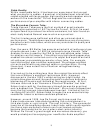8
Cable Quality:
Within reasonable limits, it has been our experience that you get
what you pay for in cables. A good set of shielded input connection
cables coupled with large gauge, high quality low-loss speaker wire is
well worth the investment. Do not degrade the remarkable
performance of your amplifier with inferior connecting cables.
The Marvelous Vacuum Tube:
Triode Vacuum Tubes were the first method of practical audio
amplification patented in 1907 by Lee De Forest. At first, he used
an open flame to produce thermionic emissions, but later found an
electrically heated filament was much more practical.
The first triodes were inefficient and often very mismatched in
performance. Thankfully we now have reliable sources of precision
manufactured triode tubes, which are very consistent in quality and
performance.
Over the years, BK Butler has experimented with virtually every type
of audio vacuum tube. In 1992 he obtained a large Vacuum Tube
Analyzer formerly used by the FAA to test and analyze radar tubes
for aviation control towers. This old but very high-quality apparatus
enabled him almost unlimited control to adjust and experiment with
virtually every conceivable parameter of any tube. For example,
input and output pins could be reassigned. B+ voltages and bias
currents switched to any desired value or configuration. During
these test, it was noted that a Phantom voltage was being
generated.
It turned out to be nothing less than the original thermionic effect
that one of Edison's assistant technicians (a Mr. Hammer)
discovered in the late 1800's while testing early light bulbs. He
noted a blue glow around the positive pole in a vacuum bulb and a
blackening of the wire and the bulb at the negative pole. At first,
this was referred to as "Hammers Phantom Shadow", but later
Edison took credit for the discovery himself (as was his practice)
and re dubbed it as "Thermionic Emission". More tests followed and
soon the first vacuum tube diode was invented. Limited at first to
rectifying AC into DC, Edison failed to make the one essential step
needed for tubes to achieve useful amplification.
However, around 1906, Lee De Forest vastly improved the
2-electrode vacuum tube diode by adding the crucial element: a
third electrode, or control grid. The rest is history. The successful
invention of the amplifying vacuum tube triode, which could regulate
the thermionic emissions of electrons from heated cathode,
became the foundation for our modern electronics industry.
Without De Forest's great insight and marvelous discovery, you
would probably not be enjoying your new Butler Audio amplifier!













